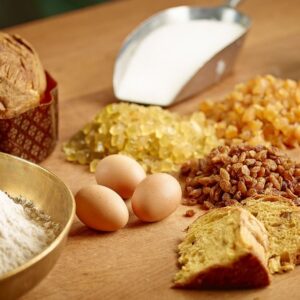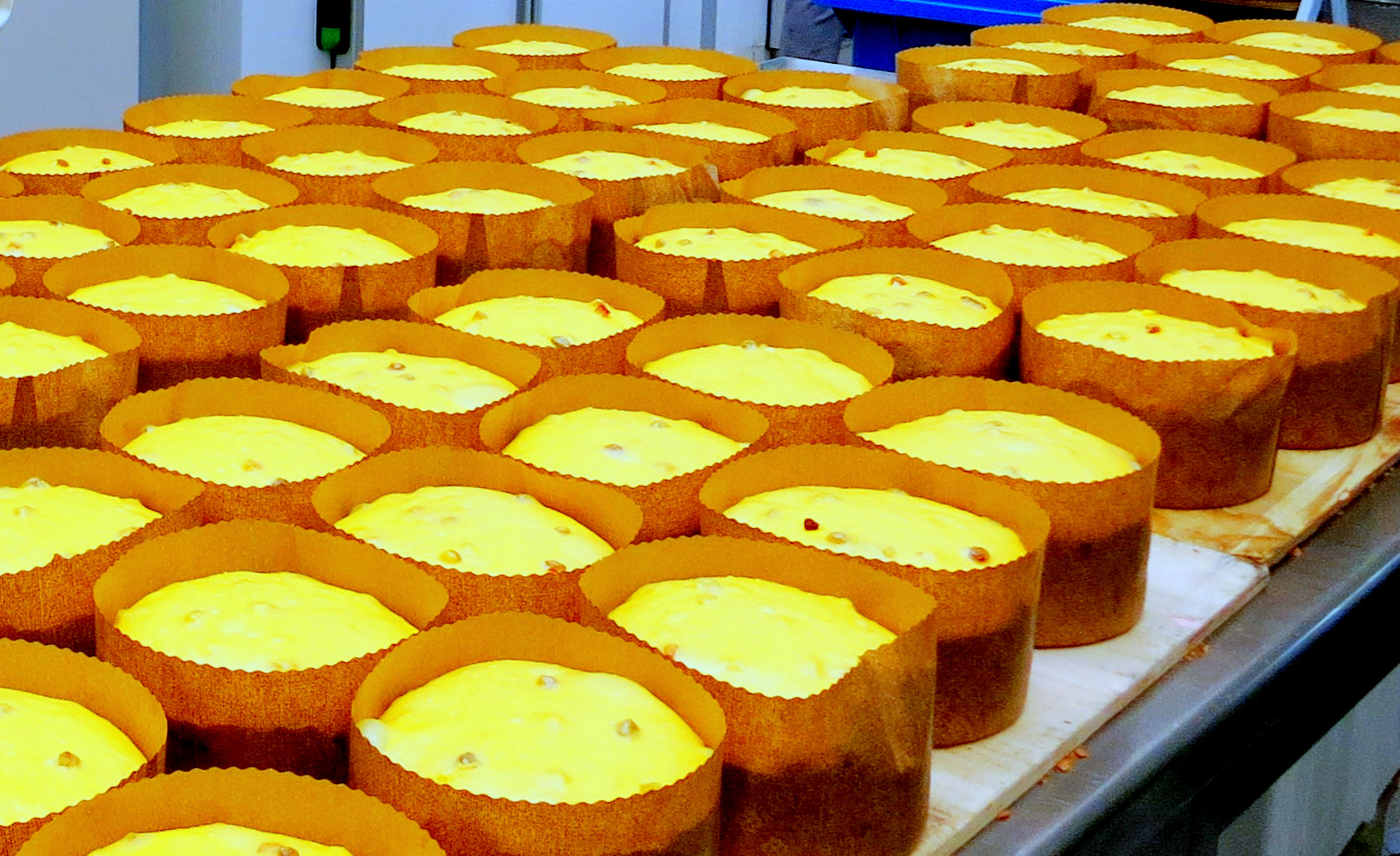Panettone translates as “a large loaf of bread”. Actually, it’s a sweet breaded cake with various creamy fillings, raisins, and candied fruits; its dome covered with toppings of different flavors. Panettone’s origins probably date to the Roman Empire: when ancient Romans sweetened a type of leavened cake with honey. During the Renaissance, when at Christmas time, bakers had permission to bake bread with wheat flour alone, it became a Milanese Christmas specialty and the legends of its origins are set there.
In fact, a manuscript written by Giorgio Valagussa, the preceptor of the House of Sforza, around 1470 and conserved in Milan’s Ambrosiana Library, mentions panettone for the first time. Milanese food blogger and author of a monograph about panettone, Stanislao Porzio recounts: “In this text, a dialogue between the master and his pupils narrates the Ceremony of the Log that the Duke’s family had celebrated since time immemorial. On the night of December 24th, a huge log, chosen so as to burn until Epiphany, was always placed in the fireplace. The pater familias, after having sprinkled it with wine and set it ablaze, cut from each of ‘three great loaves of wheat bread’, a symbol of the Trinity, a ‘particle’ (Valagussa uses precisely this Eucharistic term), which was to be set aside until the following year. Of course, all the remaining slices were distributed among those present.”

Panettone’s next literary reference dates to Cherubini’s Milanese-Italian dictionary of 1839 under the entry, Porzio tells us, Panatton or Panatton del Natal: “A kind of bread garnished with butter, eggs, sugar, and raisins or sultanas.” These pre-modern panettoni were without candied fruits and, because they lacked yeast, were flat. Again, according to Porzio, the first recipe that clearly speaks of yeast “is handed down by Gian Felice Luraschi in his Nuovo cuoco milanese economico (New Milanese Economic Cook) from 1853.”
Legend has it…
As for legends, the most popular one concerns a nobleman named Ughetto who fell in love with Adalgisa, the beautiful daughter of a baker named Toni. Ughetto’s family opposed his love for the humble baker’s daughter and blocked their marriage. Adalgisa’s father’s bakery boy unexpectedly became ill. Poor Adalgisa had to work even longer hours and so it became nearly impossible for the two lovebirds to meet. Deeply frustrated, Ughetto decided to work incognito as the bakery boy’s substitute. To make matters worse, the bakery had hit hard times; another bakery had opened nearby and was luring away customers. As a result, Adalgisa and her father sold less and less bread and were making little money.
Ughetto decided to modify his bread’s recipe by adding more butter and sugar. However, since he had no money, he sold some of his hawks (He was Duke Ludovico Maria Sforza’s hawk breeder) and luckily, made the necessary sum. His recipe was successful and soon the business started gaining back customers.
 With Adalgisa in better spirits, Ughetto added candied citron and eggs to his recipe. During the upcoming Christmas season, he also added raisins to make the recipe even more festive. Consequently, he’d not only invented a delicious “cake” which everyone in town praised, but he and Adalgisa were soon allowed to marry and lived happily ever after.
With Adalgisa in better spirits, Ughetto added candied citron and eggs to his recipe. During the upcoming Christmas season, he also added raisins to make the recipe even more festive. Consequently, he’d not only invented a delicious “cake” which everyone in town praised, but he and Adalgisa were soon allowed to marry and lived happily ever after.
A similar story recounts that panettone wasn’t the brainchild of Ughetto, but of Sister Ughetta. She lived in an impoverished convent with other young nuns: their upcoming Christmas promised to be miserable. Suddenly the situation changed: Sister had whipped up a new cake recipe. She traced a cross on its dough with a knife. When the dome-shaped crust was cooked and golden, the cross opened up, creating those bumps still visible today in traditional artisanal pannetoni.
The third legend harks back to the reigns of the Visconti and Sforza families, when during the 15th century Milan was at its peak of prosperity. For a magnificent banquet in honor of the Duke on Christmas night, the chef had prepared a special dessert, but by accident it burned to a cinder. Thank heavens, a scullery boy named Toni came to the desperate chef’s rescue. Toni explained that he’d made his Christmas cake for his family and friends using the chef’s leftovers. He offered his cake to the chef for the Duke’s banquet. The chef had no choice but to accept Toni’s generous offer. The dessert proved a huge success, and, when the Duke congratulated the chef, he gave credit where credit was due; hence the bread was named for Toni.
Throughout the ages this “tall leavened fruitcake” has made cameo appearances in the arts. It’s depicted in Peter Bruegel the Elder’s “The Peasant Wedding” (1567) and is mentioned in a contemporary recipe book by Bartolomeo Scappi (c.1500-70), personal chef to six popes. The first recorded association of panettone with Christmas can be found in the writings of 18th-century philosopher Pietro Verri. He refers to it as “Pane di Tono” (“luxury cake”).
A global cake
During the 19th century panettone’s popularity gradually spread through Northern Italy and then onto North and South America thanks to the immigrants. For example, Lombards who immigrated to Argentina, Brazil, Chile, and especially Peru transported their love of panettone, and so it’s enjoyed at Christmas with hot cocoa or liquor, now a mainstream tradition in those countries.

In the early 20th century, two enterprising Milanese bakers began to produce panettone. One was Angelo Motta, who in 1919 revolutionized traditional panettone. By adding yeast, he gave it its dome shape and now familiar light texture by making the dough rise three times for almost 20 hours before cooking. Motta’s recipe was adapted around 1925 by another baker, Gioacchino Alemagna, who also gave his name to another popular brand that still exists today. The stiff competition between the two bakers led to panettone’s industrial production.
Where to find it
After World War II, panettone became affordable for everyone and, again, thanks to immigrants to Germany, Switzerland, and Belgium gained popularity in Northern Europe. Today with the Motta and Alemagna brands owned by Bauli in Verona, Italian bakers produce some 117 million at Christmastime. In Milan, Rome, and New York for the widest selection go to the megastores Eataly; for the best artisanal selection in Milan: Pasticceria Marchesi, Pasticceria Migliavacca, Pasticceria Martesana, Pavè, and Cova; and in New York: Dean & DeLuca, Agata & Valentina, Sullivan Street Bakery, and Sant Ambroeus.












